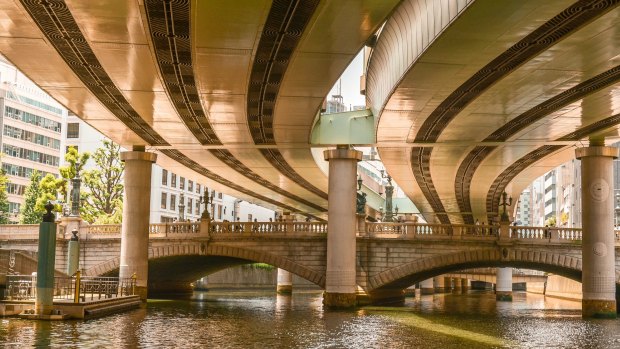
Nihonbashi is a business district of Tokyo, which grew up around the bridge of the same name which has linked two sides of the Nihonbashi River.Credit: Shutterstock
How is a mechanical clock tower supposed to look? Obvious, isn't it, and you'd think such a thing would stand out in the Tokyo streetscape but I'm outside Ningyocho Metro Station for a clock-tower rendezvous with an Urban Adventures guide who will take me on a walking tour of the district, and the clock tower has gone AWOL.
I retrace my steps, pacing back and forth through the station and popping up at different exits like a groundhog until finally I work out that the meeting point must be in between Ningyocho and Suitengumae metro stations, and voila, there's my guide. Meg Yamagute is Brazilian of Japanese descent and a long-term resident of Tokyo.
Ningyocho means "doll town", Meg tells me. Traditionally this was an artisans' quarter of the city. Not too close to the imperial palace, the yardstick of status, but not in the boondocks either. "Bunraku, puppet theatre, once flourished here, and also geisha. It was a pleasure quarter. Artisans were important to the smooth running of the city," says Meg.
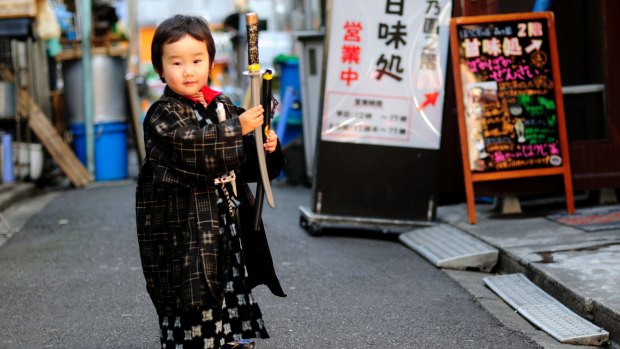
Small boy in traditional costume on the streets of Ningyocho.Credit: Meg Yamagute
As we stand waiting for two more booked guests – they fail to show – the figurines inside the clock start to dance while a wailing song starts up. It's the history of the quarter, sung in Japanese, and very cute. The figure climbing the ladder at the top of the clock represents a fireman, a vital figure in what was traditionally a fire-prone area packed with wooden houses.
Right beside us there's a shop selling little cakes made from bean curd with a chocolate-syrup coloured paste in the middle, cooked in an hinged mould like a jaffle iron over a charcoal fire. Meg shows me around and buys a couple fresh from the fire. I'm a little too hasty and the syrup inside squirts out like molten lava.
Nursing a slightly scorched mouth, we set off to explore. Ningyocho has seven Shinto shrines, Meg tells me, one for each of the local Shinto gods although there are many more in the pantheon. On New Year's Day, and for two days after, people come from all over Tokyo to visit all seven. Last new year the queues at the shrines stretched for blocks.
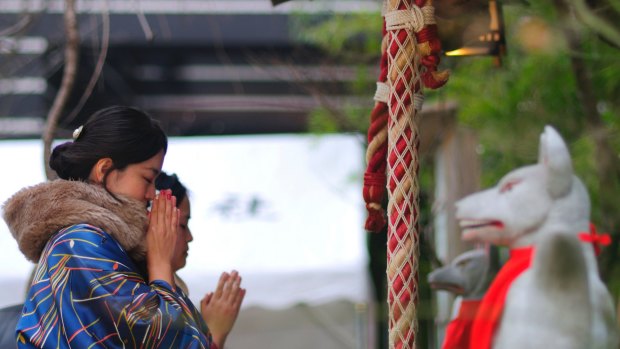
Women praying at the Chanoki Shrine, on the Seven Gods of the Good Fortune walk.Credit: Meg Yamagute
It's after 1pm when we start walking and some of the restaurants have already taken down the curtain that hangs like a frilly skirt at the front. If it's gone, the kitchen is closed, Meg says.
We pass six women in kimonos, not a usual sight on the streets of Tokyo, probably out buying traditional items that are hard to find anywhere but the back streets of Doll Town.
Our first stop is a shop that sells nothing but fans, essential for the kimono-wearing woman. Made from paper or silk, some are bright, some subtle, some painted with gold leaf and hugely expensive. My favourite opens to reveals a single bough of a cherry blossom arching across the folds in silver and soft pink.
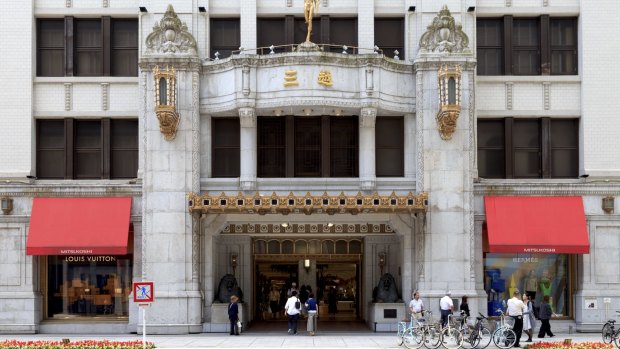
The Mitsukoshi Department Store in the Nihonbashi section of Tokyo.Credit: Shutterstock
Next is a shop that makes lacquered boxes from bamboo. They're woven in a grid pattern so air can circulate freely, used for storing your kimono. The man who makes them is elderly and when he quits, that's it. He's the last craftsman making these boxes in Tokyo.There's a shop selling wagyu beef from Kobe. It's heavily marbled, more fat than red meat. "When the Japanese first had contact with the west they were vegetarians, predominantly Buddhists," says Meg. "After, they started eating more pork and chicken but they found beef hard on their teeth so they developed wagyu beef with a high fat content, easier to eat."
We pass a restaurant specialising in fugu, the pufferfish famed for its lethal poison. Chefs require three years of expert training before they can serve fugu, although it's farmed these days, and believed not so toxic as it was since the toxin came from an algae the fish eats in the wild.
Next is a shop selling sells nothing but tofu. "Very popular with sumo wrestlers," Meg tells me, "they have to eat a lot of tofu for the protein."
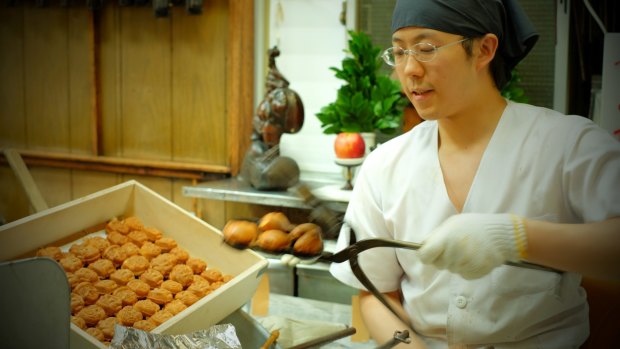
Traditional cakes made in an iron mould.Credit: Meg Yamagute
So much food is making me hungry so we stop off for a little cinnamon confection served with tea. The women serving sit on their haunches behind a wooden counter bronzed with years of polishing from bent elbows. At the front of the shop are twin bowls of salt, a Shinto concept since salt keeps evil spirits from entering. The salt would also attract bullock carts since the bullocks would stop to lick the salt, and thus the driver would be obliged to stop. The shopkeeper might then offer him tea, and perhaps driver-san would like a cake? And so thanks to salt, the wheels of commerce would grind.
One of our last stops is the Kaomi Shrine, considered very lucky because it survived the Tokyo bombing raids of World War II, and all the people who sheltered there emerged unscathed. It's a beauty, constructed from cypress wood and you have to admit Shinto is a whole lot of fun. If you like dressing up in outlandish costumes with puffy sleeves and funny hats, whacking big drums and worshiping springs, random rocks and trees, the Shinto priesthood might just be your cup of tea.
At the front is a big trough where you wash your hands with a bamboo scoop in strict order, right then left, then rinse your mouth, but only touch the left hand to the mouth, all using clean water from the spigot rather than the water in the trough. Finally you trickle water down the handle of the scoop to clean it, then return it upside down to the top of the trough. You are now pure enough to enter. Bow twice, ring the bell to attract the attention of the god and clap twice. Then go to the booth at the side and buy a prediction on a little slip of white paper. It's random. The news might be good or it might be terrible. If it's not so good, you tie it to the rope at the side of the shrine, along with hundreds of others, so you don't carry the bad luck away with you. Let the gods deal with it.
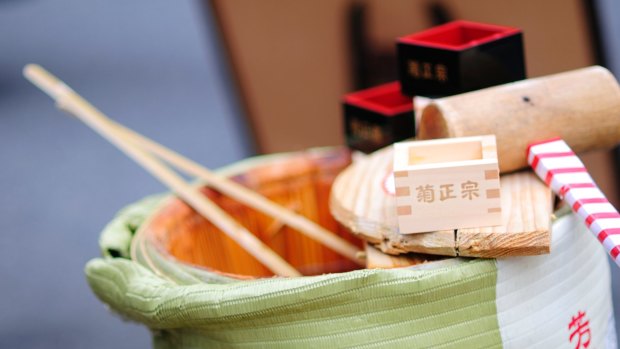
Sake barrel, opened with the hammer, during the New Year's pilgrimage of the Seven Gods of the Good Fortune shrines in Ningyocho. In front of Ningyocho Hana, a restaurant near Suehiro Shrine. Credit: Meg Yamagute
Now we're in Nihonbashi, close to the river. "The Nihonbashi Bridge was once a simple humpback bridge but it was the point from which all distances were measured," Meg says. "This was once the first of 80 guard posts on the road from Tokyo – called Edo at the time – to the imperial capital in Kyoto. It wasn't open to anyone, you needed a kind of visa."
A plaque in the centre of the bridge is still used to measure distances from Tokyo but the atmosphere is marred by the overhead expressway smack in the middle of the river. The expressway was built during the Tokyo Olympics when the city needed new roads but didn't have the money to acquire the land that would be required, so they put pylons in the river and built the expressway over the top.
Back from the bridge we pass the Mitsukoshi department store, which began in the Edo period selling kimonos and is now one of the most famous in Japan. Meg suggests I visit the food hall, alone, fearing I'll take too long, and we end up in the Coredo complex across the road.
Coredo is an emporium filled with all the stuff you need to turn your life into a thing of beauty and it's chock full of little wonders that set the heart romping in the breast – iron teapots, lacquer bowls, cosmetics, towels and more, but the standout for me is the Nihonbashi Kiya knife store. For slicing, peeling, paring and boning particularly, Japanese knives are the alpha and omega of chefs' knives, and Kiya has been making them since 1792. I settle on a paring knife and the wrapping alone makes me forget the astonishing price.
They say a Kiya knife can cut through a sponge without making a sound. While I'm not sure if this is a useful advantage in a kitchen knife, having sliced and diced Doll Town thanks to Meg, and been served with a feast that I would have missed without her, it seems the right thing to do.
TRIP NOTES
MORE
FLY
Japan Airlines has daily flights to Tokyo from Sydney, Melbourne and Cairns and daily except for Tuesday and Saturday from Gold Coast Airport. See jal.co.jp
TOUR
Japan's Cultural Curiosities, the Urban Adventures tour, costs from $72.75 per person. See urbanadventures.com/
Michael Gebicki was a guest of Urban Adventures.
Sign up for the Traveller Deals newsletter
Get exclusive travel deals delivered straight to your inbox. Sign up now.